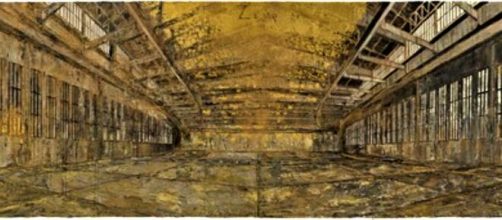Is horror a subject for a painter to make artful? Was it fitting, for example, for Peter Paul Rubens to use his mastery of Flemish realism and Italian Renaissance sensuality to picture “The Rape of the Sabine Women”?
Glaring error in judgment
I ask this because mixed media artist Anselm Kiefer, used gold in his current painting series about the Holocaust. Aside from the reasons noted below for why gold is inappropriate for this subject, this precious metal’s sunshiny glow is hardly a hue for horror.
Gold is the stuff of trophies, awards, and medals – commendations for jobs well done, not Jew-hating.
I’m thinking of the Gold Medal in the Olympics, the Golden Globe Award and the Nobel Prize.
Then there’s the age-old use of gold in religious art including Christian and Jewish objects of worship. Gian Lorenzo Bernini’s sculpture “The Ecstasy of St. Theresa” describe a saint’s mystical encounter with an angel, which Bernini glorified with gilded light beams. He was portraying ecstasy, not extermination.
Gold was also the material that God told Moses to use to cover The Ark of the Covenant. Clearly putting the lustrous metal into such exalted service is a way of amplifying something worthy of enhancement. Gold is the color of sunlight. It shines. What in hell shines in a concentration camp? How can you use this glittering metal that gives value to medals to a failure of humanity?
Mind you, none of this is to say that artists should avoid picturing evil. They’ve been doing it successfully for ages, at least since the 5th century BCE. That’s when the Etruscans made sculptures of Gorgon heads often seen in old Greek and Roman architecture. The Gorgons, mythic monsters like Medusa with fangs and snakes for hair, were known for turning their foes into stone.
Monsters made to look monstrous
But here’s the thing. Artists’ renditions of Gorgons look as monstrous as the Greek myths described. They didn’t glorify them. Picasso certainly didn’t dress up horror in his anti-war painting “Guernica.” He made it clear with a stomach-turning image of a woman holding a lifeless child in her arms screaming at the heavens as 3,000 German bombs rained down on her town.
The Nazis did more than bomb Guernica. They flew their planes low enough to machine-gun down anyone still standing. Picasso’s palette was fittingly dark with black and blue.
The Huffington Post cites Kiefer’s view of evil in his acceptance speech when he won the 2008 Peace Prize of the German Book Trade. He quoted what he describes as a rabbinic thought: "Man is a piece at whose ends God and Satan are pulling – in the end, God is clearly the stronger.” But then Kiefer added this ominous line, “I, on the other hand, believe the outcome is undecided.”
Does Kiefer’s uncertainty rate the use of gold in his Holocaust pictures? In the words of German philosopher Theodor Adorno, “to write a poem after Auschwitz is barbaric.” Gracing degradation with gold is equally black-hearted.


